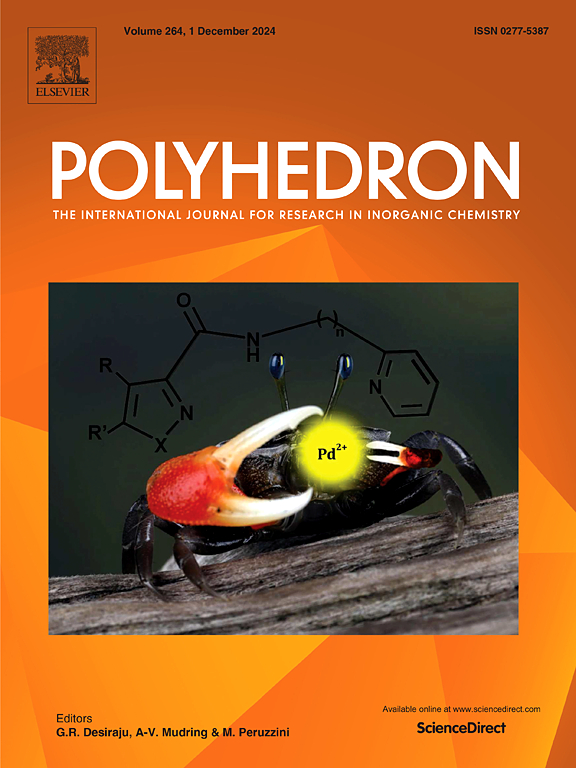基于香豆素的新型过渡金属离子探测分子探针的合成、光电性质和细胞毒性:理论与实验
IF 2.6
3区 化学
Q2 CHEMISTRY, INORGANIC & NUCLEAR
引用次数: 0
摘要
通过苯基肼与香豆素衍生物的反应,合成了4种香豆素基分子探针。利用紫外-可见吸收光谱、荧光光谱和循环伏安法系统地研究了它们对各种阴离子(F−、Cl−、Br−、I−、SO32−、H2PO4−、CH3COO−、HS−)和阳离子(Li+、Na+、Mg2+、Al3+、K+、Mn2+、Fe3+、Co2+、Ni2+、Cu2+、Cd2+)的结合性能。结果表明,探针对Cu2+、Co2+、Fe3+具有较高的选择性、灵敏度和特异性,在主客体相互作用下具有明显的比色变化,可实现视觉检测。这些发现为痕量离子传感建立了一种很有前途的方法。理论研究表明,在紫外可见光谱中观测到的红移是由涉及最高占据分子轨道(HOMO)的电子跃迁引起的。此外,细胞毒性实验证实了探针的生物相容性,表明它们在活细胞中检测细胞内离子的潜力。本文章由计算机程序翻译,如有差异,请以英文原文为准。

Synthesis, photoelectric properties and cytotoxicity of novel coumarin-based molecular probes for transition metal ions detection: Theory and experiment
Four coumarin-based molecular probes were synthesized via the reaction of phenylhydrazine and coumarin derivatives. Their binding properties toward various anions (F−, Cl−, Br−, I−, SO32−, H2PO4−, CH3COO−, HS−) and cations (Li+, Na+, Mg2+, Al3+, K+, Mn2+, Fe3+, Co2+, Ni2+, Cu2+, Cd2+) were systematically investigated using UV–Vis absorption spectroscopy, fluorescence spectroscopy and cyclic voltammetry. The results demonstrated that the probes exhibited high selectivity, sensitivity and specificity for Cu2+, Co2+, Fe3+ with distinct colorimetric changes upon host-guest interaction, enabling visual detection. These findings establish a promising approach for trace ion sensing. Theoretical studies revealed that the observed red shifts in the UV–Vis spectra originated from electron transitions involving the highest occupied molecular orbital (HOMO). Furthermore, cytotoxicity assays confirmed the probes' biocompatibility, suggesting their potential for intracellular ion detection in living cells.
求助全文
通过发布文献求助,成功后即可免费获取论文全文。
去求助
来源期刊

Polyhedron
化学-晶体学
CiteScore
4.90
自引率
7.70%
发文量
515
审稿时长
2 months
期刊介绍:
Polyhedron publishes original, fundamental, experimental and theoretical work of the highest quality in all the major areas of inorganic chemistry. This includes synthetic chemistry, coordination chemistry, organometallic chemistry, bioinorganic chemistry, and solid-state and materials chemistry.
Papers should be significant pieces of work, and all new compounds must be appropriately characterized. The inclusion of single-crystal X-ray structural data is strongly encouraged, but papers reporting only the X-ray structure determination of a single compound will usually not be considered. Papers on solid-state or materials chemistry will be expected to have a significant molecular chemistry component (such as the synthesis and characterization of the molecular precursors and/or a systematic study of the use of different precursors or reaction conditions) or demonstrate a cutting-edge application (for example inorganic materials for energy applications). Papers dealing only with stability constants are not considered.
 求助内容:
求助内容: 应助结果提醒方式:
应助结果提醒方式:


